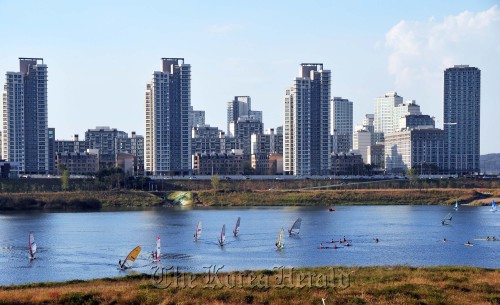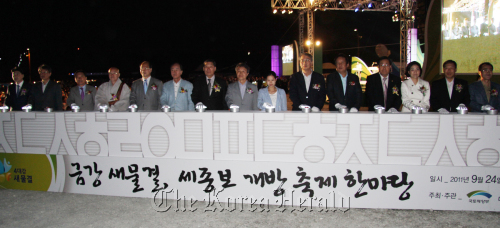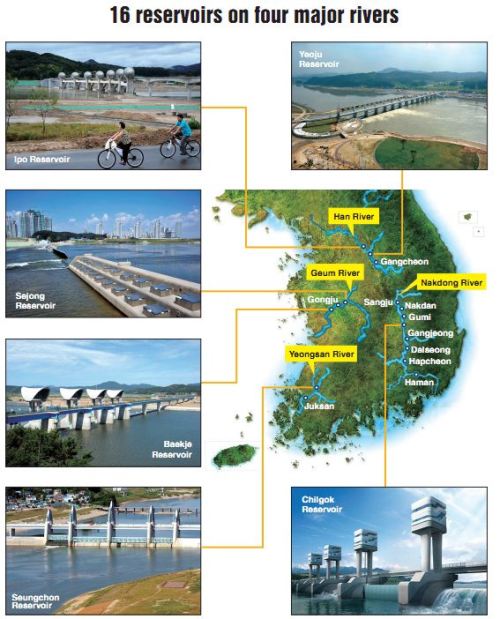New reservoirs to ratchet up water security, renewable energy use
The government’s five-year river refurbishment project epitomizes Korea’s commitment to “green growth,” a development model aimed at balancing environmental conservation and economic prosperity.
President Lee Myung-bak has stressed clean technology and sustainable development as future economic drivers under his “low carbon, green growth” mantra since he took office in 2008.
He set the goal of bringing the nation’s greenhouse-gas emissions 30 percent below projected levels by 2020 and a five-year plan to transfer 2 percent of annual gross domestic product into research and development on green infrastructure.
The government’s five-year river refurbishment project epitomizes Korea’s commitment to “green growth,” a development model aimed at balancing environmental conservation and economic prosperity.
President Lee Myung-bak has stressed clean technology and sustainable development as future economic drivers under his “low carbon, green growth” mantra since he took office in 2008.
He set the goal of bringing the nation’s greenhouse-gas emissions 30 percent below projected levels by 2020 and a five-year plan to transfer 2 percent of annual gross domestic product into research and development on green infrastructure.

The river restoration project comes as part of the government’s new development framework, focusing on improving water security, flood control and ecological balance in the basins of the nation’s four main rivers ― Han, Geum, Yeongsan and Nakdong.
The 22 trillion won ($18.7 billion) program involves renovating some 900 kilometers of tributary streams and adjacent wetlands and establishing 16 reservoirs and leisure and anti-disaster prevention facilities.
“(The project) will not only strengthen the capability to secure water and control inundation across the country, but also serve as effective means of preserving the ecosystem of these rivers,” Lee told the U.N. General Assembly in 2009.
The government has started opening some of the 16 reservoirs to the public as it is polishing up the main courses of the four rivers. The installation of small-scale hydropower plants, solar panels and windmills in the weirs is still under way.


With hydraulic turbines alone, the state-run Korea Water Resources Corp. will be able to produce 271 million kilowatts of electricity annually, according to the Ministry of Land, Transport and Maritime Affairs. That could offset 183,000 tons of emissions a year and 454,000 barrels of crude imports, which costs around 50 billion won.
The ministry will also supply electricity from photovoltaic panels in 12 reservoirs with total daily output of 109 kilowatt-hours.
“We added renewable energy to the river project to embody the low-carbon, green growth vision and cope with accelerating climate change,” Shim Myung-pil, chief of the project, told The Korea Herald.
“Even after the whole project is finished, we’re planning to set up additional wind power stations along the Geum, Yeongsan and Nakdong Rivers if proven feasible.”
The project is also expected to save 1.25 billion tons of water by building small and medium-sized dams and developing reservoirs for agricultural use, ministry officials said, while upgrading water quality by blocking and purifying dirty water near rivers.
Ministry officials said that the program has also played a vital role in invigorating local economy, creating some 190,000 jobs in the construction sector, which accounts for almost 20 percent of the nation’s GDP.
Participant builders include Samsung C&T, POSCO Engineering and Construction, Hyundai Engineering and Construction, GS Engineering and Construction and Daelim Industrial.
The government, however, has had difficulties decoupling its ambition from criticism over environmental degradation since the 2009 launch.
Opposition policymakers, civic groups and environmental activists claimed that a substantial dredging of the riverbed to dig watercourses deeper made some areas even more flood-prone. Some scholars also warned that the project puts local wildlife at risk and undermines ecosystem dynamics.
“I think the program had been taken too politically,” Shim said, adding that the Land Ministry is closely watching the habitats of endangered species and stepping up protection measures for them.
Shim said that residents, who opposed the project over its environmental impact, have turned increasingly positive as they see the renovated waterways and once-feeble streams get through torrential rains last summer without flooding.
According to the Land Ministry, the country’s total flood damage during the rainy season is valued at 94.5 billion won, just about 9 percent of what was needed in 1998 and 6 percent compared with 2006.
“It is fortunate that the government has been building four times as many anti-disaster facilities as the current ones under the program in preparation for a rainstorm that might come once in 200 years,” Lee said in August.
“Because of this project, many waterside areas can stave off recurrent flood damage.”
Korea is now setting its sights on overseas markets to export its technology for urban stream restoration, Shim said.
Morocco, Paraguay, Malaysia and Vietnam are currently considering adopting Korea’s scheme for their own projects, he noted. King Mohammed VI of Morocco has dispatched several envoys here to discuss a partnership.
Paraguay’s Tourism Minister, Liz Rosanna Cramer Campos, is visiting Seoul this week to look into the matter with Shim.
“Water security emerged as a global issue because climate change has likely prompted extreme weather conditions that come with droughts, floods and water shortages even in rich countries,” Shim said.
“The project would help the countries raise a safeguard against recurrent floods and boost tourism revenue.”
By Shin Hyon-hee (heeshin@heraldcorp.com)



![[Exclusive] Korean military set to ban iPhones over 'security' concerns](http://res.heraldm.com/phpwas/restmb_idxmake.php?idx=644&simg=/content/image/2024/04/23/20240423050599_0.jpg&u=20240423183955)




![[Pressure points] Leggings in public: Fashion statement or social faux pas?](http://res.heraldm.com/phpwas/restmb_idxmake.php?idx=644&simg=/content/image/2024/04/23/20240423050669_0.jpg&u=)










